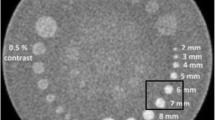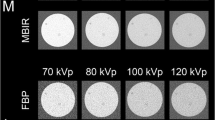Abstract
Objectives
To compare image quality [low contrast (LC) detectability, noise, contrast-to-noise (CNR) and spatial resolution (SR)] of MDCT images reconstructed with an iterative reconstruction (IR) algorithm and a filtered back projection (FBP) algorithm.
Methods
The experimental study was performed on a 256-slice MDCT. LC detectability, noise, CNR and SR were measured on a Catphan phantom scanned with decreasing doses (48.8 down to 0.7 mGy) and parameters typical of a chest CT examination. Images were reconstructed with FBP and a model-based IR algorithm. Additionally, human chest cadavers were scanned and reconstructed using the same technical parameters. Images were analyzed to illustrate the phantom results.
Results
LC detectability and noise were statistically significantly different between the techniques, supporting model-based IR algorithm (p < 0.0001). At low doses, the noise in FBP images only enabled SR measurements of high contrast objects. The superior CNR of model-based IR algorithm enabled lower dose measurements, which showed that SR was dose and contrast dependent. Cadaver images reconstructed with model-based IR illustrated that visibility and delineation of anatomical structure edges could be deteriorated at low doses.
Conclusion
Model-based IR improved LC detectability and enabled dose reduction. At low dose, SR became dose and contrast dependent.
Key Points
• Model- based Iterative Reconstruction improves detectability of low contrast object.
• With model- based Iterative Reconstruction, spatial resolution is dose and contrast dependent.
• Model-based Iterative Reconstruction algorithms enable improved IQ combined with dose-reduction possibilities.
• Improvement of SR and LC detectability on the same IMR data set would reduce reconstructions.





Similar content being viewed by others
References
Kak ACS, M. (1988) Principles of Computerized Tomographic Imaging Principles of Computerized Tomographic Imaging. Institute for Electrical and Electronic Engineers, IEEE Press
Geyer LL, Schoepf UJ, Meinel FG et al (2015) State of the art: iterative CT reconstruction techniques. Radiology 276:339–357
Mehta D (2013) Iterative model reconstruction: simultaneously lowered computed tomography radiation dose and improved image quality. Med Phys Int J 1:9
Brown KZS, Koehler T (2012) Acceleration of ML iterative algorithms for CT by the use of fast start images. Physics of Medical Imaging, San Diego
Goldman LW (2007) Principles of CT: radiation dose and image quality. J Nucl Med Technol 35:213–225, quiz 226–218
(2011) Size-Specific Dose Estimates (SSDE) in Pediatric and adult body CT examinations. American Association of Physicists in Medicine, pp 1–26
(2014) Use of water equivalent diameter for Calculating Patient Size and Size-Specific Dose Estimates (SSDE) in CT. American Association of Physicists in Medicine, pp 1–23
Mieville FA, Gudinchet F, Brunelle F, Bochud FO, Verdun FR (2013) Iterative reconstruction methods in two different MDCT scanners: physical metrics and 4-alternative forced-choice detectability experiments–a phantom approach. Phys Med 29:99–110
Rossmann K (1969) Point spread-function, line spread-function, and modulation transfer function. Tools for the study of imaging systems. Radiology 93:257–272
Richard S (2012) Towards task-based assessment of CT performance: system and object MTF across different reconstructions algorithms. Med Phys 39
Naylor DA, Tahic MK (2007) Apodizing functions for Fourier transform spectroscopy. J Opt Soc Am A Opt Image Sci Vis 24:3644–3648
Neroladaki A, Botsikas D, Boudabbous S, Becker CD, Montet X (2013) Computed tomography of the chest with model-based iterative reconstruction using a radiation exposure similar to chest X-ray examination: preliminary observations. Eur Radiol 23:360–366
Gervaise A, Osemont B, Lecocq S et al (2012) CT image quality improvement using adaptive iterative dose reduction with wide-volume acquisition on 320-detector CT. Eur Radiol 22:295–301
Saiprasad G, Filliben J, Peskin A et al (2015) Evaluation of low-contrast detectability of iterative reconstruction across multiple institutions, CT scanner manufacturers, and radiation exposure levels. Radiology. doi:10.1148/radiol.2015141260:141260
Klink T, Obmann V, Heverhagen J, Stork A, Adam G, Begemann P (2014) Reducing CT radiation dose with iterative reconstruction algorithms: the influence of scan and reconstruction parameters on image quality and CTDIvol. Eur J Radiol 83:1645–1654
Korn A, Fenchel M, Bender B et al (2012) Iterative reconstruction in head CT: image quality of routine and low-dose protocols in comparison with standard filtered back-projection. AJNR Am J Neuroradiol 33:218–224
Rapalino O, Kamalian S, Kamalian S et al (2012) Cranial CT with adaptive statistical iterative reconstruction: improved image quality with concomitant radiation dose reduction. AJNR Am J Neuroradiol 33:609–615
Baker ME, Dong F, Primak A et al (2012) Contrast-to-noise ratio and low-contrast object resolution on full- and low-dose MDCT: SAFIRE versus filtered back projection in a low-contrast object phantom and in the liver. AJR Am J Roentgenol 199:8–18
Kilic K, Erbas G, Guryildirim M, Arac M, Ilgit E, Coskun B (2011) Lowering the dose in head CT using adaptive statistical iterative reconstruction. AJNR Am J Neuroradiol 32:1578–1582
Pickhardt PJ, Lubner MG, Kim DH et al (2012) Abdominal CT with model-based iterative reconstruction (MBIR): initial results of a prospective trial comparing ultralow-dose with standard-dose imaging. AJR Am J Roentgenol 199:1266–1274
Schindera ST, Odedra D, Raza SA et al (2013) Iterative reconstruction algorithm for CT: can radiation dose be decreased while low-contrast detectability is preserved? Radiology 269:511–518
McCollough CH, Yu L, Kofler JM et al (2015) Degradation of CT low-contrast spatial resolution due to the use of iterative reconstruction and reduced dose levels. Radiology 276:499–506
Li K, Garrett J, Ge Y, Chen GH (2014) Statistical model based iterative reconstruction (MBIR) in clinical CT systems. Part II. Experimental assessment of spatial resolution performance. Med Phys 41:071911
Love A, Olsson ML, Siemund R, Stalhammar F, Bjorkman-Burtscher IM, Soderberg M (2013) Six iterative reconstruction algorithms in brain CT: a phantom study on image quality at different radiation dose levels. Br J Radiol 86:20130388
Acknowledgments
A poster has been presented based on these results at the ECR 2015. The scientific guarantor of this publication is Pr Emmanuel COCHE.The authors of this manuscript declare relationships with the following companies: Alain Vlassenbroek is an employee of Philips Healthcare. The authors state that this work has not received any funding. One of the authors has significant statistical expertise. Institutional Review Board approval was obtained. Written informed consent was waived by the Institutional Review Board. Methodology: experimental, performed at one institution.
Author information
Authors and Affiliations
Corresponding author
Rights and permissions
About this article
Cite this article
Millon, D., Vlassenbroek, A., Van Maanen, A.G. et al. Low contrast detectability and spatial resolution with model-based Iterative reconstructions of MDCT images: a phantom and cadaveric study. Eur Radiol 27, 927–937 (2017). https://doi.org/10.1007/s00330-016-4444-x
Received:
Revised:
Accepted:
Published:
Issue Date:
DOI: https://doi.org/10.1007/s00330-016-4444-x




